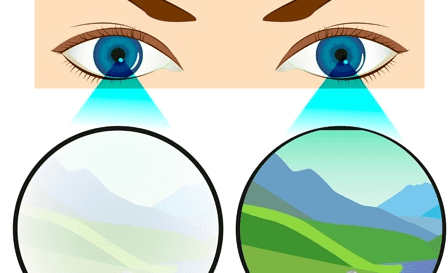Contents
Amblyopie
Amblyopia is a one-sided visual impairment that is typically seen in young children. We often speak of a “lazy eye”. The images transmitted by this eye are ignored by the brain, which leads to progressive loss of vision. This can be corrected if it is taken care of in time, usually within eight years. The management of amblyopia in adults is much more difficult.
Amblyopia, what is it?
Definition of amblyopia
Amblyopia is characterized by a difference in visual acuity between the two eyes. One is said to be “lazy eye”: the images transmitted by this eye are of insufficient quality to be processed by the brain. This one will ignore these images, a phenomenon which will gradually lead to a progressive loss of vision. This deterioration in vision can become permanent if it is not taken care of in time.
Types d’amblyopie
It is possible to distinguish several forms of amblyopia. The most common is functional amblyopia. It constitutes a visual defect during childhood. The brain ignores images from one of the two eyes, which affects vision.
There are other forms of amblyopia such as organic amblyopia which is linked to eye damage. This form is rare. This is why the medical term amblyopia often refers to functional amblyopia.
Causes of amblyopia
Three major causes have been identified:
- eye misalignment, a phenomenon more commonly referred to as strabismus;
- focusing problems, or refractive errors, which can manifest as hyperopia (fuzzy perception of objects located nearby) or astigmatism (deformation of the cornea);
- an obstruction of the visual axis between the surface of the eye and the retina which can occur in particular during a congenital cataract (total or partial opacity of the lens present from birth or appearing in the first months of life).
Diagnosis of amblyopia
Amblyopia is identified by screening for visual disturbances. Early screening is essential because treatment depends on it. Amblyopia in adults is much more difficult to manage than when diagnosed in children.
Screening for visual disturbances is based on visual acuity tests. However, these tests are not applicable or relevant in very young children. They are not necessarily able to speak or give an objective answer. Screening can then be based on the analysis of pupillary reflexes. This can be done by photodetection: a recording of pupillary reflexes using a camera.
People affected by amblyopia
Amblyopia usually develops during visual development before the age of 2 years. It is estimated that it affects around 2 to 3% of children. Amblyopia can be corrected if caught on time, usually before eight years of age. Beyond that, amblyopia in adolescents and adults is more difficult to manage.
Risk factors for amblyopia
Certain factors can promote the development of amblyopia in children:
- hyperopia, considered the main risk factor;
- an asymmetric refraction abnormality;
- a family history of refractive errors;
- prematurity;
- malformations;
- trisomy 21;
- palsy in the brain;
- neuro-motor disorders.
Symptoms of amblyopia
Signs in young children
Amblyopia usually manifests itself in children in their first few months. During this period, it is often difficult to (re) know the symptoms felt by children. He is not yet able to clearly express his feelings. In addition, he is not aware that he has a visual disturbance. However, signs may suggest the presence of amblyopia in children:
- the child narrows his eyes;
- the child covers one eye;
- the child has eyes that look in different directions.
Symptoms in older children
From the age of about three, screening for visual disturbances is easier. The child may complain of a visual disturbance: a blurred perception of objects located near or at a distance. In all cases, a medical consultation is advised if in doubt about the symptoms of amblyopia.
Symptoms in adolescents and adults
The situation is similar in adolescents and adults. Amblyopia is usually seen with unilateral vision loss.
Treatments for amblyopia
The management of amblyopia involves stimulating the use of the lazy eye by the brain. To achieve this, several solutions can be employed such as:
- wearing glasses or contact lenses;
- the application of dressings or eye drops which prevent the use of the unaffected eye and thus oblige the mobilization of the affected eye;
- cataract removal if the situation requires it;
- treatment of strabismus if necessary.
Prevent amblyopia
There are no solutions to prevent amblyopia. On the other hand, it is possible to prevent complications by regularly checking your child’s vision with a health professional. The prevention of complications also involves following up on medical recommendations after the diagnosis of amblyopia.










